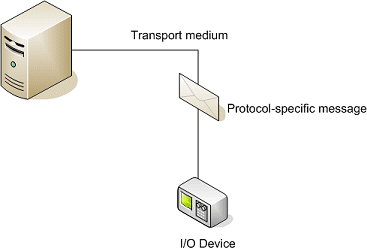
CitectSCADA can communicate with any control or monitoring I/O Device that has a communication port or data exchange interface, including PLCs (programmable logic controllers), loop controllers, bar code readers, scientific analyzers, remote terminal units (RTUs), and distributed control systems (DCS).
Typical CitectSCADA communications consists of four key parts:

These components work in unison to expose the inputs and outputs of an I/O Device to a CitectSCADA system.
The transport medium does not need to be a direct cable as shown in the diagram; it can be any means of carrying the message – such as a high-speed wireless link or an FDDI network. Similarly, the protocol-specific message could be a simple ASCII message or a complex object-based message such as DNP 3. Engineers are free to assemble different combinations of I/O Devices, transports, and protocols.
See Also